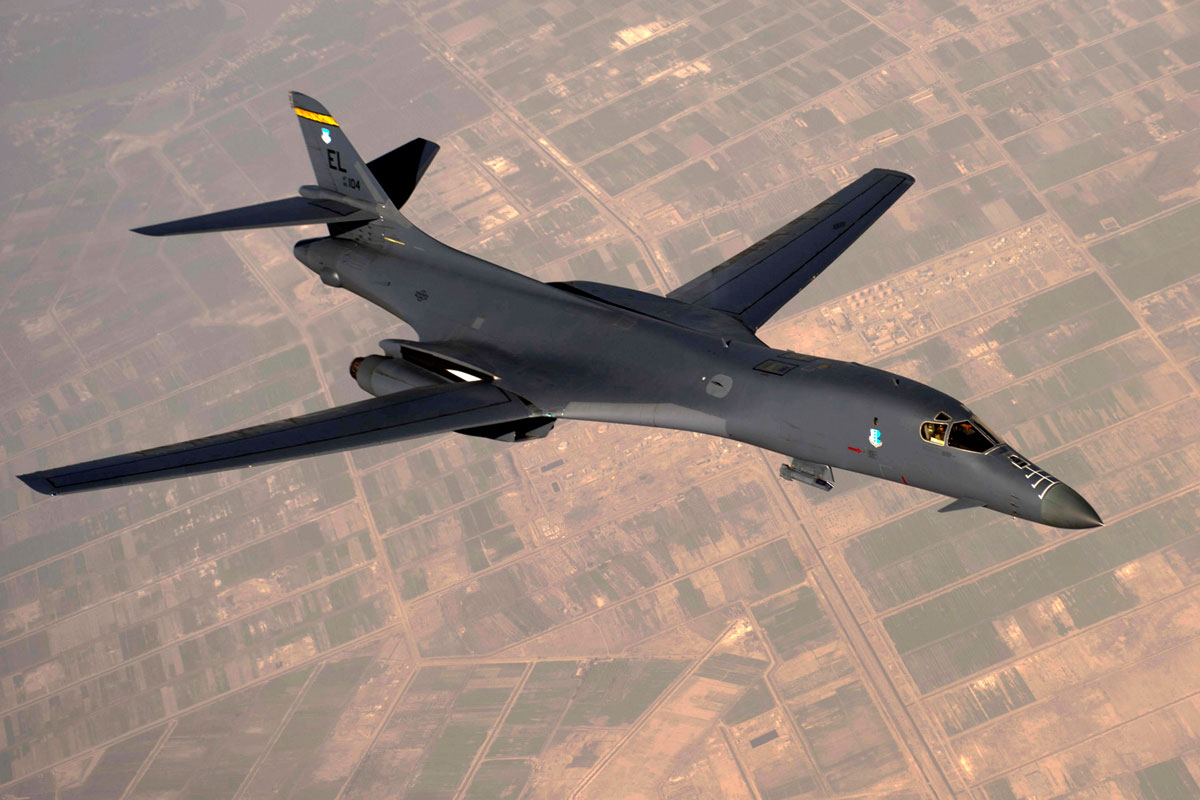US Airstrikes in the Middle East: A Deepening Conflict with Historical Context
The recent US airstrikes against Iranian-backed militia groups in Syria and Iraq mark a significant escalation in tensions within a region already scarred by decades of conflict. Understanding the current situation requires a broader historical perspective of US involvement in the Middle East and its history of bombings.
A Legacy of Intervention:
- 2001: Following the 9/11 attacks, the US invaded Afghanistan, igniting a long-lasting war that continues to this day.
- 2003: The US invaded Iraq based on claims of weapons of mass destruction, which later proved false. This destabilized the region and empowered Shiite militias with ties to Iran.
- 2011: The US supported a NATO intervention in Libya, leading to the overthrow of Muammar Gaddafi and subsequent instability.
- 2014-2019: The US intervened in Syria against the Islamic State (ISIS), leading to complex alliances and further regional involvement.
Escalating Tensions:
- 2020: US airstrikes killed Iranian General Qassem Soleimani, escalating tensions and leading to Iranian missile attacks on US bases in Iraq.
- 2021: The US withdrew troops from Afghanistan in a chaotic manner, emboldening the Taliban and raising concerns about Iranian influence.
- 2023: A series of drone and missile attacks on US bases in the Middle East, attributed to Iranian-backed militias, led to the latest US airstrikes.
Current Situation:
- The recent US airstrikes targeted command centers, weapons caches, and facilities linked to Iranian-backed militias in Syria and Iraq.
- While claiming “precision,” concerns remain about potential civilian casualties.
- The White House claims to be avoiding a wider war with Iran, but the future trajectory remains uncertain.
Looking Ahead:
- The recent escalation could embolden both sides, leading to further attacks and regional instability.
- Diplomatic efforts are crucial to de-escalate tensions and prevent a wider conflict.
- Understanding the historical context of US involvement in the region is essential for analyzing the current situation and its potential consequences.
In recent weeks, escalating tensions between the United States and Iran have raised concerns about the possibility of open conflict. As geopolitical maneuvering and military posturing intensify, the world watches with apprehension, mindful of the potential consequences of a direct confrontation between these two influential nations.
Here’s an exploration of some U.S. listed companies that have historically seen increased revenue due to ongoing global conflicts.
Defense Contractors and Suppliers
- Lockheed Martin Corporation (LMT): As one of the world’s largest defense contractors, Lockheed Martin plays a pivotal role in supplying advanced technologies, aircraft, and systems to military forces globally. Its products range from fighter jets like the F-35 to missile defense systems.
- Northrop Grumman Corporation (NOC): Specializing in aerospace and defense technology, Northrop Grumman is known for producing unmanned aircraft systems, missile defense solutions, and cyber warfare capabilities.
- Boeing (BA): Beyond its commercial aircraft division, Boeing’s defense, space, and security segment provides military aircraft, satellites, and integrated defense systems to various governments.
- Raytheon Technologies Corporation (RTX): A conglomerate formed through the merger of Raytheon Company and United Technologies Corporation, RTX focuses on aerospace and defense, producing everything from missiles and defense systems to cybersecurity solutions.
- General Dynamics Corporation (GD): This diversified aerospace and defense company offers a broad portfolio of products and services, including combat vehicles, munitions, shipbuilding, and aerospace systems.
Security and Intelligence Solutions
- Palantir Technologies Inc. (PLTR): Palantir specializes in big data analytics, with significant contracts from governments and defense agencies worldwide for intelligence analysis and surveillance.
- CACI International Inc. (CACI): Providing information solutions and services in support of national security missions and government transformation, CACI plays a role in areas like cybersecurity, intelligence, and enterprise IT.
Table: U.S. Listed Companies Benefiting from Ongoing Global Conflicts
| Company Name | Ticker Symbol | Primary Sector | Notable Products/Services |
|---|---|---|---|
| Lockheed Martin Corporation | LMT | Aerospace & Defense | Fighter jets, missile systems, defense technologies |
| Northrop Grumman Corporation | NOC | Aerospace & Defense | Unmanned aircraft, missile defense, cyber solutions |
| Boeing | BA | Aerospace & Defense | Military aircraft, satellites, integrated defense systems |
| Raytheon Technologies Corporation | RTX | Aerospace & Defense | Missiles, defense systems, cybersecurity solutions |
| General Dynamics Corporation | GD | Aerospace & Defense | Combat vehicles, munitions, shipbuilding, aerospace systems |
| Palantir Technologies Inc. | PLTR | Security & Intelligence Solutions | Big data analytics, intelligence analysis, surveillance |
| CACI International Inc. | CACI | Security & Intelligence Solutions | Cybersecurity, intelligence, enterprise IT |
Disclaimer: While these companies are recognized for their involvement in defense and security sectors, it’s essential to approach this topic with nuance. The presence of these companies in conflict-related activities is a complex matter influenced by various geopolitical, ethical, and economic factors.
Chances of War
- Historical Context: The history of U.S.-Iran relations has been marked by periods of tension, notably since the Islamic Revolution in 1979. Disputes over Iran’s nuclear program, regional influence, and differing political ideologies have fueled a complex and often adversarial relationship.
- Nuclear Deal Uncertainty: The 2015 Joint Comprehensive Plan of Action (JCPOA), commonly known as the Iran Nuclear Deal, aimed to curb Iran’s nuclear ambitions. However, the U.S. withdrawal from the agreement in 2018, followed by the reimposition of sanctions, created a strained diplomatic environment.
- Recent Provocations: Incidents in the Gulf region, including attacks on oil tankers and the downing of drones, have heightened tensions. The U.S. has accused Iran of engaging in destabilizing activities, while Iran contends that it is merely safeguarding its interests in the face of perceived threats.
- Military Buildup and Posturing: Both the U.S. and Iran have engaged in military maneuvers and strategic deployments, flexing their military might in a display of strength. Such actions, while intended to deter, also risk miscalculation and unintended escalation.
- Regional Proxy Conflicts: The influence of both nations extends beyond their borders, with involvement in regional conflicts such as those in Syria, Yemen, and Iraq. These proxy battles have become arenas for geopolitical competition, adding another layer of complexity to U.S.-Iran relations.
- International Diplomacy: Efforts by the international community, particularly through diplomatic channels like the United Nations, have sought to defuse tensions and encourage dialogue. However, finding common ground amid deeply entrenched differences remains a formidable challenge.
- Global Ramifications: A military conflict between the U.S. and Iran would have far-reaching consequences. The stability of the entire Middle East, global energy markets, and the broader geopolitical landscape would be significantly impacted.
As the U.S. finds itself on the brink of war with Iran, the international community anxiously awaits developments and calls for diplomatic solutions. The complex interplay of historical grievances, regional dynamics, and strategic considerations underscores the urgency of finding peaceful resolutions to prevent further escalation and foster stability in a critical region of the world.
US forces have begun a new bombing campaign in the Middle East to punish Iran’s Islamic Revolutionary Guards (IRGC) Quds Force and affiliated militia groups for a series of drone and missile attacks on American military bases in the region.
Washington’s latest airstrikes began around midnight Baghdad time on Saturday and hit more than 85 targets in Syria and Iraq, the US Central Command (CENTCOM) said in a statement. The operation involved “numerous aircraft,” including long-range bombers flown from the US, which dropped over 125 precision munitions on their targets.
Those targets included command and control centers, intelligence sites, weapons caches, and supply-chain facilities of Iranian-backed militias, as well as “their IRGC sponsors who facilitated attacks against US and coalition forces,” CENTCOM said.
The bombings follow a series of assaults on American military bases in the Middle East, including a drone attack that killed three American soldiers and wounded more than 40 others at secretive US installation in Jordan. That base, called Tower 22, is located near the Syrian and Iraqi borders.
The attack on Tower 22 was “planned, resourced and facilitated” by the Islamic Resistance in Iraq, White House National Security Council spokesman John Kirby said on Wednesday. The group consists of multiple militias, including Kataib Hezbollah, which has launched multiple rocket and drone strikes against US forces in the region since the Israel-Hamas war began in October.
Kirby suggested that the US response would be carried out over multiple days. It “won’t just be a one-off,” he said. “As I said, the first thing you see will not be the last thing.” He added that Biden is still trying to avoid a broader war with Iran.
Media reports in recent days raised concern that Biden was telegraphing his plans and giving the militias too much time to take preparatory steps, such as vacating obvious targets. Pentagon chief Lloyd Austin tried to deflect those worries on Friday, denying that the administration was giving Iran too much warning. He said the US response will be “multi-tiered” and insisted that neither he nor Biden would tolerate attacks on American troops.
Biden has blamed Iran for supplying the weapons that Islamic militants have used in attacking US forces in the Middle East more than 150 times since the Israel-Hamas war started. He has faced political pressure to respond aggressively, including calls by Republican lawmakers to launch devastating strikes inside Iran.
The IRGC’s Quds Force is an elite unit that specializes in guerilla warfare and intelligence-gathering outside Iran. It has sought to drive American forces out of neighboring Iraq since the US invasion in 2003.
Barack Obama’s administration provided financial assistance to Iran as part of the Joint Comprehensive Plan of Action (JCPOA), commonly known as the Iran Nuclear Deal. The key elements of the aid and sanctions relief provided to Iran under the JCPOA included:
- Release of Frozen Assets: The JCPOA involved the release of frozen Iranian assets, primarily held in foreign banks due to international sanctions. These assets were unfrozen, allowing Iran to access previously restricted funds.
- Sanctions Relief: The agreement led to the lifting of certain international economic sanctions against Iran, including those related to its nuclear program. This sanctions relief was contingent upon Iran’s compliance with the terms of the deal.
- Nuclear-related Aid: While not direct financial aid, the JCPOA allowed for the provision of nuclear-related assistance to Iran. This assistance aimed to support Iran’s peaceful use of nuclear energy while preventing the development of nuclear weapons.
- Implementation of the JCPOA: The deal required the international community, particularly the P5+1 countries (the United States, United Kingdom, France, Germany, Russia, and China, plus the European Union), to cooperate in implementing the agreed-upon measures. This collaboration included the gradual lifting of sanctions and facilitating Iran’s reintegration into the global economy.
It’s important to note that the JCPOA was a complex diplomatic agreement, and the aid provided was conditional on Iran’s compliance with restrictions on its nuclear program. The deal aimed to address concerns about Iran’s nuclear activities in exchange for sanctions relief. However, the situation evolved, and in 2018, the United States, under President Donald Trump, withdrew from the JCPOA and reimposed sanctions on Iran.
The involvement of the United States in the Middle East has included various wars, military operations, and bombings over the years. Here is a list of some significant events:
- Gulf War (1990-1991): Operation Desert Shield and Desert Storm were launched in response to Iraq’s invasion of Kuwait. The U.S.-led coalition, including many Middle Eastern and Western countries, expelled Iraqi forces from Kuwait.
- Iraq War (2003-2011): The U.S.-led invasion of Iraq aimed to eliminate weapons of mass destruction (WMDs) and topple Saddam Hussein’s regime. It resulted in a protracted conflict and insurgency, lasting for several years.
- War in Afghanistan (2001-present): Following the 9/11 attacks, the U.S. led an international coalition in the invasion of Afghanistan to oust the Taliban regime and eliminate al-Qaeda. The conflict has continued for many years, evolving into a complex situation involving various factions.
- Operation Inherent Resolve (2014-present): The U.S. has been involved in airstrikes against ISIS (Islamic State of Iraq and Syria) targets in Iraq and Syria as part of the broader international coalition’s efforts to counter the extremist group.
- Bombing of Libya (2011): The U.S. participated in a NATO-led intervention in Libya, conducting airstrikes to support rebels against the regime of Muammar Gaddafi.
- Syrian Civil War (2014-present): The U.S. has been involved in the Syrian conflict, initially targeting ISIS and later supporting various groups. Airstrikes and military operations have been conducted against both ISIS and, at times, the Syrian government.
- Drone Strikes in Yemen and Pakistan: The U.S. has conducted drone strikes against suspected terrorists in Yemen and Pakistan, often associated with groups like al-Qaeda.
However, despite its strategic interests and interventions, the U.S. has faced numerous challenges and encountered failures in effectively managing Middle East politics.
- Complex Geopolitical Landscape: The Middle East is characterized by a complex web of ethnic, religious, and political rivalries. U.S. policymakers often grapple with navigating the intricate relationships among nations and groups, leading to unintended consequences.
- Intervention in Iraq and Afghanistan: The U.S. invasion of Iraq in 2003, based on intelligence about weapons of mass destruction, resulted in long-lasting instability and sectarian strife. Similarly, the protracted engagement in Afghanistan has struggled to bring about lasting stability, despite extensive military and financial investments.
- Arab Spring and Unforeseen Consequences: The Arab Spring uprisings in 2010-2011 brought both hope and chaos to the region. While the U.S. supported popular movements calling for democratic reforms, the aftermath saw power vacuums, civil wars, and the rise of extremist groups in countries like Libya and Syria.
- Failure to Resolve Israeli-Palestinian Conflict: The U.S. has historically sought to broker peace between Israel and Palestine. However, the decades-long conflict persists, and multiple peace initiatives have faced challenges, contributing to regional tensions.
- Changing Alliances and Unpredictable Dynamics: The fluid nature of alliances in the Middle East adds another layer of complexity. U.S. relationships with regional powers such as Saudi Arabia, Turkey, and Iran have experienced shifts, and unforeseen geopolitical events further complicate diplomatic efforts.
- Struggle Against Terrorism: While the U.S. has aimed to combat terrorism in the region, its interventions have sometimes inadvertently fueled radicalization. Groups like ISIS emerged in the power vacuum left by conflicts, posing significant challenges to regional stability.
- Overreliance on Military Solutions: U.S. policy in the Middle East has often leaned heavily on military interventions, sometimes at the expense of diplomatic and political solutions. This approach has not always translated into sustainable stability.
The challenges and failures in U.S. Middle East policy underscore the intricacy of managing a region with deep-rooted historical, cultural, and political complexities. Moving forward, a comprehensive and nuanced approach that combines diplomacy, regional collaboration, and an understanding of local dynamics will be essential to address the persistent challenges and foster stability in the Middle East.
Shayne Heffernan









